Vatic Note: If you have been following the Vatic Project, you know that we believe from all historical writings of the ancients in almost every religion, both western and eastern and based on a Mayan Shaman alive today, that the arrival of Nibiru or December 21, 2012 is "nothing to fear", rather, the Shaman says in the Mayan Calendar that its the "return of the Ancestors and Wisemen" and its an exciting time instead of a fearful time. We will be putting up a part 3 to reinforce that position. It is very bad news for the evil ones, of that I am sure.
I apologize for the lay out since I do not know how to work these things, so I am asking Bruecke to fix it. Hopefully he is still around on a friday. LOL Otherwise, you may have to wait until Monday. Thanks for your patience.
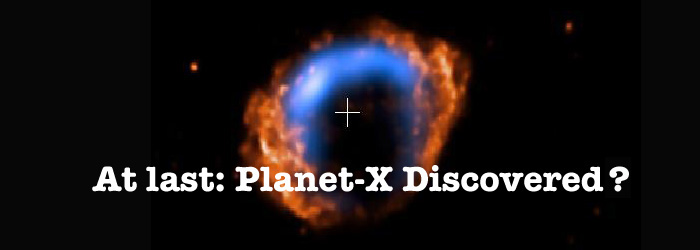
Spanish Astronomers Claim Dwarf Sun Beyond Pluto - Part I of 2
by Gary Vey for viewzone
The idea of a new planet being discovered in our Solar System is pretty exciting. Even more so because of the many theories about "planet-x" or "Nibiru" being associated with space aliens and the doomsday prophecies of 2012.
Scientists at places like NASA and famous observatories have deflected inquiries about the discovery for a few years now, mainly because they feared being associated with these "fringe" theories. But like it or not -- it has happened. Well... according to a team of Spanish artronomers who call themselves the StarViewer Team.
The group made the rounds of all the news web sites in the past two weeks, claiming they discovered something very significant. It's almost twice the size of Jupiter and just beyond our furthest planetoid, Pluto. Although it's not a planet, it appears to have planets or large satellites encircling it. It's what astronomers call a "brown dwarf star" and its official name is "G1.9".
What's a Brown Dwarf Star?
First we'll explain WHAT these astronomers have discovered. Then we'll discuss HOW they discovered it.
At the risk of being scientifically vague, I'll try to explain the current understanding of how stars and planets form in space.
All matter attracts other matter. A larger mass will attract smaller masses towards it. In space this results in growing clouds of matter that tend to clump together and attract more matter. Since most of the matter in space is gaseous, these clouds eventually get so dense that they collapse into dense gaseous spheres.
When they do this there is usually some "left over" matter that forms a ring around the sphere.
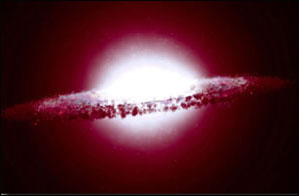
If there is enough matter in a sphere of hydrogen, for example, it can cause so much compression at the shpere's core that the hydrogen atoms begin to fuse together and a fusion-reaction ignites a new born star. In this reaction two hydrogen atoms join together to form one helium atom and release extra energy as radiation.
Scientists believe that the minimum mass needed to ignite a sun is about 13 times the known mass of the planet Jupiter -- written as "13MJ." If the mass is lower than this, the pressure in the core is not enough to ignite and the sphere will be hot ball of gas called a "brown dwarf."
As a new star spins, the disk surrounding it gradually cools and the matter forms heavier elements like metals and minerals. These "rocks" eventually clump together and form solid spheres called planets.
Sometimes a solid sphere will attract some of the gas that is in the disk and this will result in a gaseous giant, like Jupiter and Saturn, which has a solid core but a thick gaseous atmosphere. These "gas giant" planets can be very massive but, because of their solid cores, they will never ignite and become stars.
This Brown Dwarf
This newly discovered "brown dwarf" is believed to have formed from the same condensed matter that gave birth to our Sun. It is believed that, after the large planets formed around the Sun, they pushed it to the edge of the Solar system where it formed a sphere about 1.9MJ -- well below the mass needed to ignite it as a "sun."
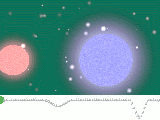
Nemesis The theory of a companion sun is not new. It has often been described as Nemesis, after the Greek figure in mythology.
The mythological Nemesis was the spirit of divine retribution against those who succumb to hubris, vengeful fate personified as a remorseless goddess. The name Nemesis is related to the Greek word meaning "to give what is due".
Nemesis is now often used as a term to describe one's worst enemy, normally someone or something that is the exact opposite of oneself but is also somehow similar. For example, Professor Moriarty is frequently described as the nemesis of Sherlock Holmes.
"Opposite yet similar" is the perfect description for a companion to our Sun. But the name Nemesis also implies a sinister nature. Will this new Nemesis be beneficial or harmful to our lives?
Many suns that we observe in the galaxy are part of binary systems or double stars. There is debate about how two suns form from a single condensed cloud of matter. Some believe that they both form at the same time; others believe they split following the creation of one huge sun.
Sometimes both spheres are capable of fusion and both suns shine brightly, encircling each other around an imaginary point call the barycenter. Sometimes only one sun attains 13MJ and ignites, while its smaller companion, the brown dwarf, glows dimly and radiates heat. Astronomers usually can only see the brightest of the two, but because they both circle around a common barycenter, the wobble reveals the mass of the unseen companion.
We are close to our Sun and within its gravitational influence. So as we are travel through space, it appears to us that the G1.9 is moving in an elipse between our furthest planetoid, Pluto, and the edge of our Solar system, near the Oort Cloud.
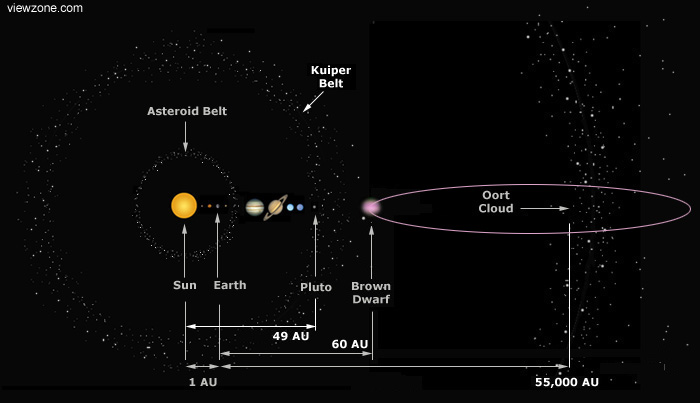
The newly discovered brown dwarf is reported to be located just about 60 to 66 AU (1 AU=the distance from the Sun to Earth) from us (its parigee), currently in the direction of the constellation Sagittarius. Because of periodic gravitational disturbances in areas of space further out, specifically in the Oort Cloud, the Spanish group of astronomers believe G1.9 travels in an elliptical orbit extending possibly hundreds of AU beyond the furthest known planets (its apogee). Its position just beyond Pluto suggests it is at its closest approach to the Sun and Earth.
Space appears relatively free of debris [see image above] inside the planetary orbits. This is because the gravitational pull of each planet (a large mass) effectively collects the interplanetary debris (small mass). But there are exceptions.
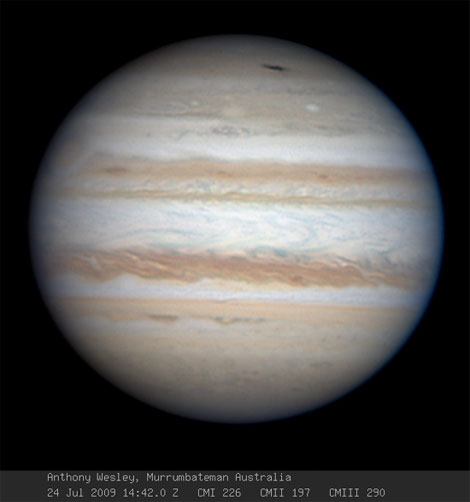
Belts of Debris Between Mars and Jupiter you will see a ring of debris called The Asteroid Belt. It is believed that a planet once orbited in this area before it was pulverized by some type of impact. Many theorists believe this was caused by a rogue planet that entered the Solar System -- again hinting at the existence of some unknown member of our planetary system.
Beyond the furthest planetoid, Pluto, there is a large ring of debris called the Kuiper Belt.
While the asteroid belt is composed primarily of rock and metal, the Kuiper belt objects are composed largely of frozen volatiles (termed "ices"), such as methane, ammonia and water.
As we get to the edge of the Solar System we enter another debris zone, the Oort Cloud. The Oort is not a band of debris but rather a spherical shell that surrounds the Solar System and extends out to the edge of the Sun's gravitational field.
This region is thought to contain frozen clumps of water, methane, ethane, carbon monoxide and hydrogen cyanide. It's also the birth place of comets. However, the discovery of the object 1996-PW, an asteroid in an orbit more typical of a long-period comet, suggests that the cloud may also be home to rocky objects.
Debris "fly-paper"
Jupiter and Saturn are extremely massive and have such strong gravity that they attract meteors and comets entering the planetary zone of our Solar System. They protect smaller planets like our Earth from impacts, acting like a fly-paper for meteors, comets and asteroids.
In August of 2009, Jupiter captured a large asteroid that entered the planetary zone unexpectedly, despite the efforts of astronomers to track these dangerous objects. It is believed that this asteroid was perturbed by the trajectory of G1.9, which until now, was not recognized and accounted for.
Note: The dark spot [ top right] in the northern hemisphere of Jupiter where the asteroid impact was.
How it was discovered... the controversy
You might well ask why astronomers have never detected this object before. In fact they did. G1.9 was first identified as a "supernova remnant" in 1984 by Dave Green of the University of Cambridge and later studied in greater detail with NRAO's Very Large Array radio telescope in 1985. Because it was unusually small for a supernova it was thought to be young -- less than about 1000 years old.
But in 2007, X-ray observations made with NASA's Chandra X-ray Observatory revealed that the object was much larger than the last time it was observed! It had grown in size by 16%. Puzzled by this observation, the Very Large Array repeated its observations of 23 years ago and verified that it had increased in size considerably. Knowing that supernova do not expand this quickly, unless they have just exploded, they explained that G1.9 must be a "very young" supernova -- perhaps not more than 150 years old. But no record of a visible supernova has been found corresponding to that historical period (about the time of the American Civil War).
Spanish astronomers have tracked this object with great interest because they were anticipating its appearance. Gravitational anomalies have been appearing in the Oort Cloud for some time, suggesting the perturbations were caused by a nearby object with considerable mass. The announcement that G1.9 had increased in size was no mystery to them. It is exactly what they would expect as the object moved closer to Earth.
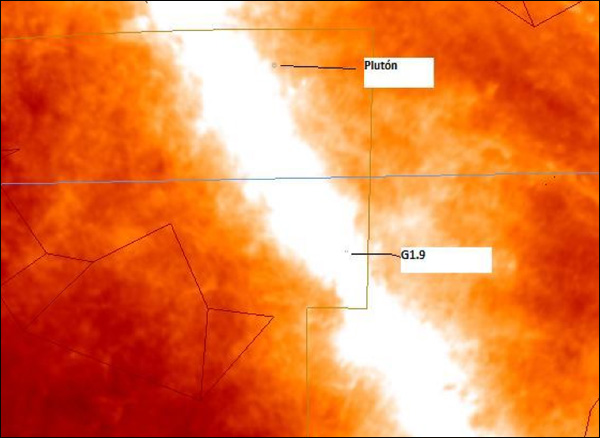
The object, G1.9 [above right] is currently located in the direction of our Galaxy's center, Sagittarius, which glows bright in this infrared spectrum image. Because of the bright background G1.9 is not visible in normal light wavelengths.
CONTINUED in Part II Next
|
The article is reproduced in accordance with Section 107 of title 17 of the Copyright Law of the United States relating to fair-use and is for the purposes of criticism, comment, news reporting, teaching, scholarship, and research.






No comments:
Post a Comment